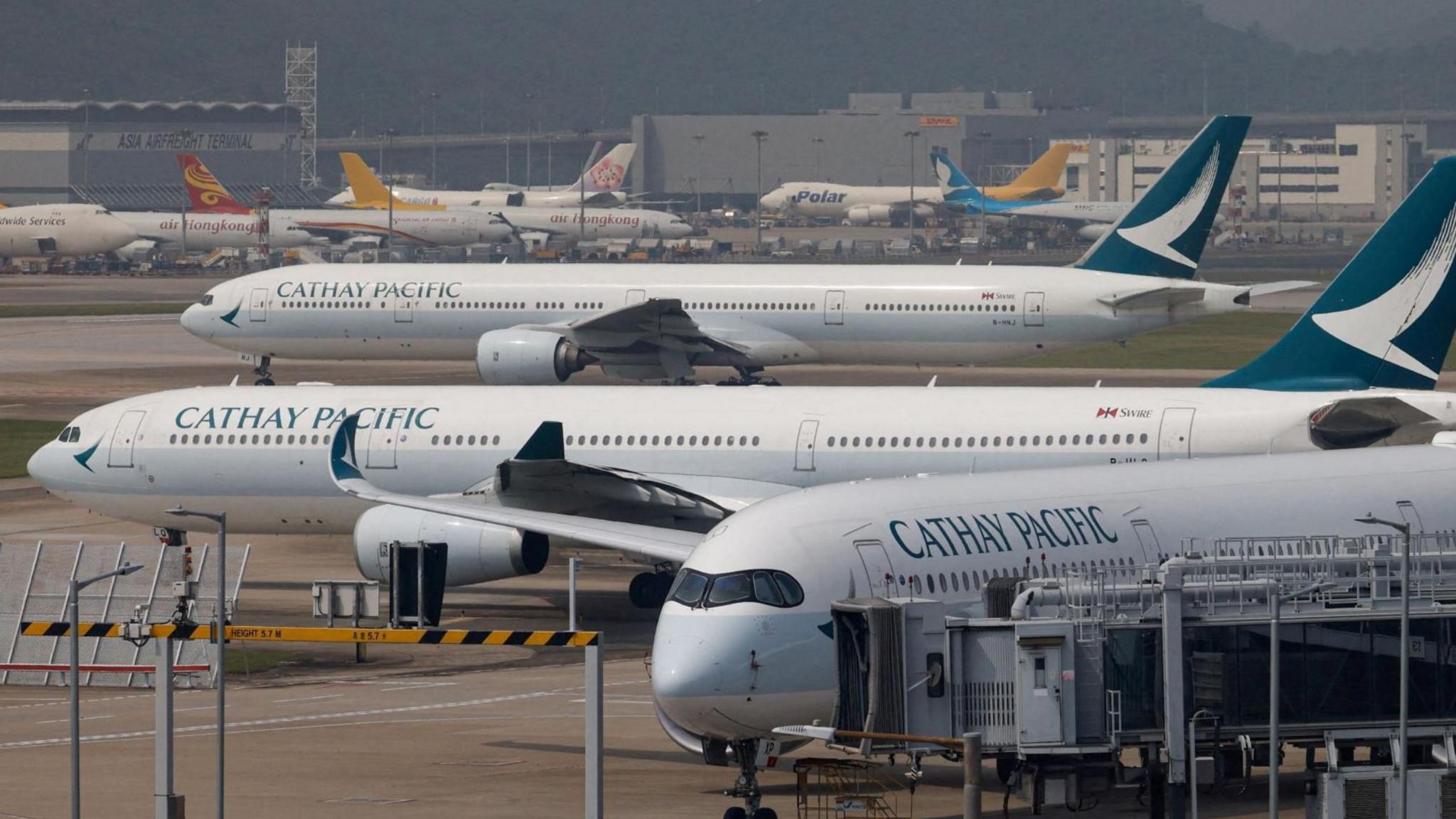Cathay Airbus fault could have caused major damage

- Published
An engine fire on a Cathay Pacific Airbus A350 earlier this month was the result of a fuel leak and could have caused extensive damage to the plane, according to investigators.
Hong Kong’s flagship airline grounded planes after being forced to turn a flight around a couple of weeks ago because of an "engine component failure".
The Trent XWB-97 engine was made by British engineering giant Rolls-Royce.
A preliminary report by Hong Kong's Air Accident Investigation Authority (AAIA) said the incident was caused by a broken fuel hose - one of a number that had been damaged.
Rolls-Royce and Cathay Pacific both said they were continuing to support the investigation.
The incident occurred shortly after the plane had taken off from Hong Kong en route to Zurich in early September. The pilots received a fire warning in the cockpit, shut down the engine and deployed fire extinguishers.
The aircraft, which was carrying 348 passengers and crew, landed safely back in Hong Kong.
But the incident raised concerns over the safety of the engines used across Cathay Pacific's A350 fleet, particularly after checks revealed issues on another 15 aircraft.
The preliminary report found that the protective surround of a fuel hose had ruptured, leaving "a discernible hole in the hose". There were signs of a fire in parts of the engine, including soot and burn marks.
Further checks revealed another five fuel hoses in the same engine were also defective.
If not promptly detected and addressed, the report said, external, this situation could have escalated "into a more serious engine fire, potentially causing extensive damage to the aircraft."
To address the problem, the AAIA recommended that the European Union Aviation Safety Agency (EASA) require Rolls-Royce to develop new inspection requirements for the relevant engines.
EASA responded in the days after the incident by requiring operators using the same type of engine to carry out inspections of fuel pipes, and remove any that were 'potentially compromised'.
It has since replaced those emergency measures with a wider regime of inspections covering several variants of the Trent XWB engine. The agency said inspections had shown that "a specific cleaning process available during engine refurbishment" could lead to degradation of the fuel hoses.
In a statement, Cathay Pacific said that following the incident it had "proactively initiated a fleet-wide inspection of its Airbus A350 aircraft that cleared the aircraft for operation." It added it was in full compliance with EASA's directive, and continued to "work closely with the airframe and engine manufacturers and regulator".
Cathay Pacific took delivery of its first Airbus A350 in 2016. The aircraft is rapidly becoming a mainstay of airlines' long-haul fleets around the world. Its main selling point is its high efficiency and low running costs.
A key part of that efficiency is the engine. The Trent XWB was developed by Rolls-Royce specifically for the A350. The incident initially raised concerns that there could be a serious problem affecting the global A350 fleet. That would have been a major setback for the British manufacturer.
Cathay Pacific grounds planes after engine problem
- Published4 September 2024
Boeing suspends jobs for thousands after strike
- Published18 September 2024
However, it rapidly became apparent that the issue did not affect the running parts within the engine itself, but rather fuel lines on the outside. That meant the problem could be rectified relatively quickly, without an expensive redesign.
It was initially thought the problem was confined to the XWB-97, a high power variant of the engine that was fitted to a relatively limited number of long-range aircraft. However, EASA has now demanded checks on other versions as well.
Responding to the investigators' report, Rolls-Royce said "We are continuing to work closely with the regulators to support the ongoing investigation by the authorities into Cathay Pacific flight CX383"
It went on to emphasise that "the engine and aircraft system promptly detected and addressed the issue, as expected with such an incident", with the crew being alerted and able to deploy the fire extinguisher.
This year, Rolls-Royce announced plans to invest heavily to improve its range of engines, including the Trent XWB-97.
In 2023, Tim Clark, the boss of gulf carrier Emirates, voiced concerns about the durability of the engine and the prices Rolls-Royce charged for maintenance.